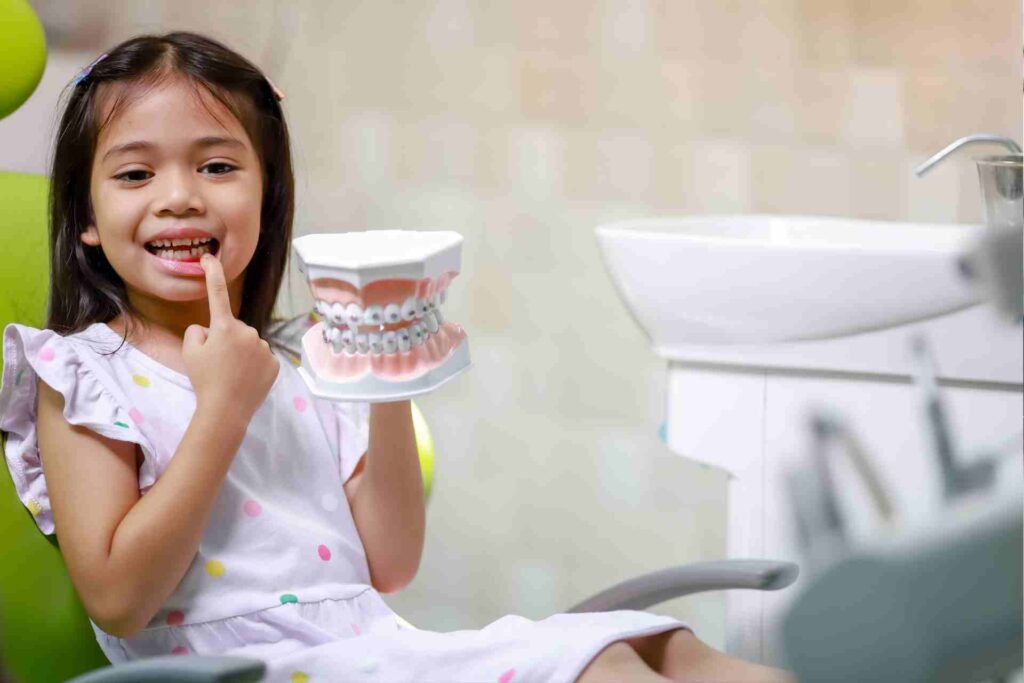Highlights:
Specialized training helps dentists understand autism spectrum disorders.
Pre-visit preparations, like office tours, can reduce anxiety.
Sensory-friendly environments accommodate hypersensitivities.
Desensitization techniques gradually build comfort with dental procedures.
Collaboration with caregivers ensures personalized care plans.
Children with autism spectrum disorder (ASD) often face challenges with dental visits due to sensory sensitivities and communication differences. Recognizing these challenges, dentists have developed specialized methods to provide compassionate and effective care.
Dentists care for autistic kids by using:
- sensory-friendly environments
- pre-visit preparations
- gentle desensitization techniques
- tailored communication strategies
They work closely with caregivers to create personalized care plans, reduce anxiety, and ensure a comfortable, effective dental experience for the child.
Specialized Training for Dental Professionals
Dentists and their teams undergo specialized training to better understand the complexities of autism spectrum disorder (ASD). This education is essential for providing compassionate, effective care tailored to the unique needs of autistic children.
Through this training, dental professionals learn to:
Recognize common sensory triggers: Understand how lights, sounds, textures, and smells may overwhelm some autistic children and adjust the environment accordingly.
Implement effective communication techniques: Use simple language, visual aids, and nonverbal cues to help the child understand what’s happening and feel more at ease.
Adapt procedures to meet individual needs: Modify appointment length, treatment methods, and even the tools used to minimize discomfort and anxiety.
This training helps dental teams create a welcoming, sensory-friendly space where autistic children can feel safe, comfortable, and understood during their visit.
Pre-Visit Preparations
For many autistic children, new environments and unfamiliar routines can cause anxiety—especially when it comes to dental visits.
To help ease these concerns, dentists often recommend pre-visit preparations that make the experience more predictable and comfortable.
Office Tours
Visiting the dental office ahead of time allows the child to explore the environment without the pressure of treatment.
Walking through the space, seeing the dental chair, and meeting the team can familiarize them with sights, sounds, and smells, reducing fear on the actual appointment day.
Social Stories
Social stories are visual and written narratives that outline what will happen during the dental visit. These stories use simple language and pictures to explain each step, helping the child understand what to expect and feel more prepared.
Here are some examples of what a dental visit social story might include:
1. “Going to the Dentist”
“Today, I am going to the dentist. The dentist helps keep my teeth healthy and clean. When I arrive, I will check in at the front desk and wait in a chair until my name is called. It might feel new, but it’s okay—everyone is there to help me.”

2. “Sitting in the Dental Chair”
“The dental chair goes up and down like a ride. I will sit in the chair and put on a bib to keep my clothes clean. The dentist or hygienist might wear a mask and gloves—that’s to keep everything clean and safe. If I need a break, I can raise my hand.”

3. “Getting My Teeth Cleaned”
“The dentist will use special tools to clean my teeth. Some tools make noises or tickle my mouth, but they won’t hurt me. I can hold my favorite toy if I want. When the cleaning is done, I might get to choose a sticker or small prize.”

4. “Meeting the Dentist and Helpers”
“I will meet friendly people who will take care of my teeth. They will tell me what they are doing so I know what to expect. It’s okay to ask questions or let them know if I need a break.”

5. “Hearing New Sounds and Smelling New Things”
“I might hear buzzing or feel water spray during my visit. I might also smell new things. If I don’t like a sound, I can wear headphones. Everyone wants me to feel comfortable.”

Tips for Using Social Stories:
- Read the story several times before the appointment.
- Use real photos of your child’s actual dental office, if possible.
- Practice at home by role-playing the steps with a toothbrush and mirror.
- Pair the story with positive reinforcement (e.g., praise, stickers) after reading.
Tip: Ask your dentist if they provide customized social stories or visual schedules tailored to their office procedures!
Parental Discussions
Dentists collaborate with parents and caregivers to learn about the child’s specific needs, preferences, and potential triggers.
These discussions help the dental team:
- Identify effective calming strategies
- Understand communication preferences
- Adjust the appointment length or timing to suit the child’s routine
By involving caregivers and taking time to prepare, dentists can build trust with the child and significantly reduce anxiety associated with dental visits.
Creating a Sensory-Friendly Environment
Many autistic children experience sensory sensitivities that can make dental visits overwhelming. To help manage these sensitivities, dental offices often modify their environment to create a calming, supportive atmosphere.
These adjustments reduce stress and make the visit more comfortable for both the child and their caregivers.
Adjusting Lighting
Bright lights in dental offices can be overstimulating for children with light sensitivity. To help:
- Dentists may use softer, dimmable lighting in treatment rooms.
- Children can wear sunglasses to block harsh lights.
- Some offices use natural lighting or offer the option to dim overhead lights during the appointment.
Minimizing Noise
Loud noises from dental equipment or bustling waiting rooms can be unsettling. To reduce auditory overstimulation:
- Offices may lower background noise or play calming music.
- Noise-canceling headphones or earplugs are often provided or encouraged.
- Dentists may explain any sounds beforehand so the child knows what to expect.
Providing Comfort Items
Familiar objects can offer emotional support and comfort during the visit. Dental teams often encourage to:
- Bring personal items like a favorite toy, blanket, or stuffed animal.
- Use weighted blankets to provide calming sensory input.
- Allow the child to hold a parent’s hand or sit with them during certain parts of the visit.
Desensitization and Gradual Exposure Techniques
For many autistic children, familiarity and repetition are key to feeling comfortable in new environments—especially at the dentist’s office. To help them acclimate to dental procedures, dentists often use desensitization and gradual exposure techniques. These strategies aim to reduce anxiety, build trust, and improve cooperation over time.
Short, Non-Invasive Visits
Rather than jumping into complex treatments, dentists may start with brief, stress-free appointments that focus on:
- Meeting the dental team
- Sitting in the dental chair without pressure to undergo treatment
- Exploring the office and equipment at the child’s own pace
These introductory visits help the child become familiar with the setting, reducing fear during future appointments.
Positive Reinforcement
Encouragement and rewards can make dental visits more positive. Dentists and caregivers might use:
- Verbal praise (e.g., “You’re doing great!”)
- Stickers, small toys, or tokens as a reward after cooperative behavior
- Visual reward charts to track progress over multiple visits
Reinforcing positive behavior motivates the child and makes future visits more manageable.
Step-by-Step Exposure
Gradual exposure involves introducing dental instruments and procedures in small, non-threatening steps, such as:
- Showing the tools without using them.
- Letting the child touch or hold harmless instruments.
- Demonstrating sounds or sensations (like the air blower) away from the mouth.
- Gently practicing procedures (e.g., brushing one tooth) before moving on to full cleanings.
This patient, slow-paced approach helps build the child’s confidence and reduces sensory overwhelm.
Communication Strategies
Effective communication is essential when caring for autistic children during dental visits. Dentists tailor their approach to match the child’s communication style, ensuring the child feels understood and supported.
Visual Aids
Many autistic children are visual learners, so using images helps them better understand what to expect. Dentists may use:
- Pictures or diagrams to show the steps of the procedure
- Visual schedules outlining the sequence of the visit
- Videos or social stories to demonstrate dental cleanings or exams
Seeing what will happen beforehand can make the experience less intimidating.
Simple Language
When explaining procedures, dentists use clear and concise words to avoid confusion or overwhelm. This includes:
- Giving one-step instructions (e.g., “Open your mouth” instead of complex explanations)
- Avoiding medical jargon that may be confusing or scary
- Using positive phrasing (e.g., “We’re going to count your teeth” instead of “We’re going to check for cavities”)
Straightforward communication keeps instructions easy to follow and reduces stress.
Nonverbal Cues
Understanding a child’s comfort level goes beyond words. Dentists observe nonverbal signals such as:
- Body language (tensing, fidgeting, or pulling away)
- Facial expressions that indicate discomfort or distress
- Gestures or movements that may signal the need for a break
Dentists may also use their own nonverbal communication, like gentle nods or calm facial expressions, to reassure and comfort the child.
Being attuned to nonverbal cues helps the dental team adjust their approach in real-time, ensuring the child stays as comfortable as possible.
Behavioral Techniques and Support
Dentists use a variety of behavioral strategies to help children with autism feel calm, safe, and more in control of their experience. These methods empower the child, reduce stress, and encourage cooperation.
Use of Distraction
Distraction techniques redirect the child’s focus away from potentially stressful aspects of the visit. Dentists may use:
- Music: Letting the child listen to calming tunes or their favorite songs through headphones
- Videos: Playing cartoons or familiar shows on overhead screens during treatment
- Storytelling: Engaging the child in conversation or simple stories to capture their attention
Keeping the child’s mind occupied helps minimize anxiety and sensory overload.
Implementing Relaxation Techniques
Simple relaxation strategies can soothe nerves and make the visit more manageable. These might include:
- Deep breathing exercises: Guiding the child to take slow, calming breaths before and during procedures
- Counting games: Using number sequences to keep the child focused and relaxed
- Gentle pressure or weighted blankets: Providing comforting sensory input for some children
Relaxation techniques promote calmness and help the child better tolerate the appointment.
Offering Choices
Giving children a sense of control during their dental visits can significantly reduce anxiety. Dentists may offer choices such as:
- Selecting the flavor of toothpaste
- Choosing a prize or sticker after the visit
- Deciding whether to sit up or lie back slowly in the dental chair
Even small decisions make the child feel involved and respected, improving cooperation.
Collaboration with Caregivers
Gather Comprehensive Histories
Understanding the child’s background allows the dental team to anticipate challenges and tailor care accordingly. Dentists ask caregivers about:
- Medical history: Including any medications, allergies, or conditions affecting treatment
- Previous dental experiences: What worked well and what caused distress in the past
- Sensory triggers and preferences: Identifying sounds, lights, or textures that may be overwhelming
This information helps create a dental visit that’s safe, comfortable, and personalized.
Develop Individualized Care Plans
Every autistic child is different, so dentists collaborate with caregivers to:
- Adjust appointment lengths based on the child’s tolerance
- Plan for breaks or gradual exposure to dental tools and procedures
- Incorporate specific calming techniques (like using weighted blankets or favorite music)
- Create a step-by-step approach that builds comfort over multiple visits
An individualized plan ensures that dental care aligns with the child’s specific needs and preferences.
Provide At-Home Care Guidance
Consistent oral care between dental visits is essential. Dentists support caregivers by offering:
- Tips for brushing and flossing with sensory sensitivities in mind
- Visual aids or tools to make at-home care more engaging
- Advice on toothpaste flavors and toothbrush types suited for the child’s comfort
- Guidance on building positive oral hygiene routines through reinforcement and choice
Helping caregivers maintain oral health at home reinforces the progress made during dental visits.
Use of Sedation When Necessary
In cases where anxiety or behavioral challenges are significant, sedation options may be considered, such as:
- Nitrous Oxide: A mild sedative to help the child relax.
- Oral Sedation: Medication taken before the appointment to reduce anxiety.
- General Anesthesia: Used for extensive procedures or when other methods are ineffective.
The decision to use sedation is made collaboratively, prioritizing the child’s safety and comfort.
Key Takeaways
- Dentists employ specialized training and strategies to provide effective dental care for autistic children.
- Pre-visit preparations and sensory-friendly environments help reduce anxiety.
- Collaboration with caregivers ensures personalized and compassionate care.
- Desensitization techniques and tailored communication foster positive dental experiences.
- When necessary, sedation options are considered to ensure the child’s comfort during procedures.
For more insights and tips on pediatric dental care, follow @joycethedentist.
FAQs
How can I prepare my autistic child for a dental visit?
Introduce the dental setting gradually with pre-visit tours, use social stories to explain what to expect, and discuss your child’s needs with the dental team beforehand.
What sensory accommodations can dentists provide?
Many dental offices offer dimmed lights, noise-canceling headphones, weighted blankets, and quiet rooms to make the environment more comfortable.
How do dentists handle sensory sensitivities during treatment?
Dentists use desensitization techniques, slow introductions to equipment, and short, non-invasive visits to ease sensory challenges.
Is sedation safe for autistic children during dental procedures?
Yes, when deemed necessary, mild sedation options like nitrous oxide or oral sedatives are safely administered under professional supervision, with the child’s comfort and safety as top priorities.
What can I do at home to improve my autistic child’s oral hygiene?
Use visual schedules, soft-bristled toothbrushes, and positive reinforcement. Let your child choose their toothbrush or toothpaste flavor to increase cooperation.
When should my autistic child start seeing a dentist?
It’s recommended to schedule your child’s first dental visit by their first birthday or when the first tooth appears to establish early oral care habits.





















